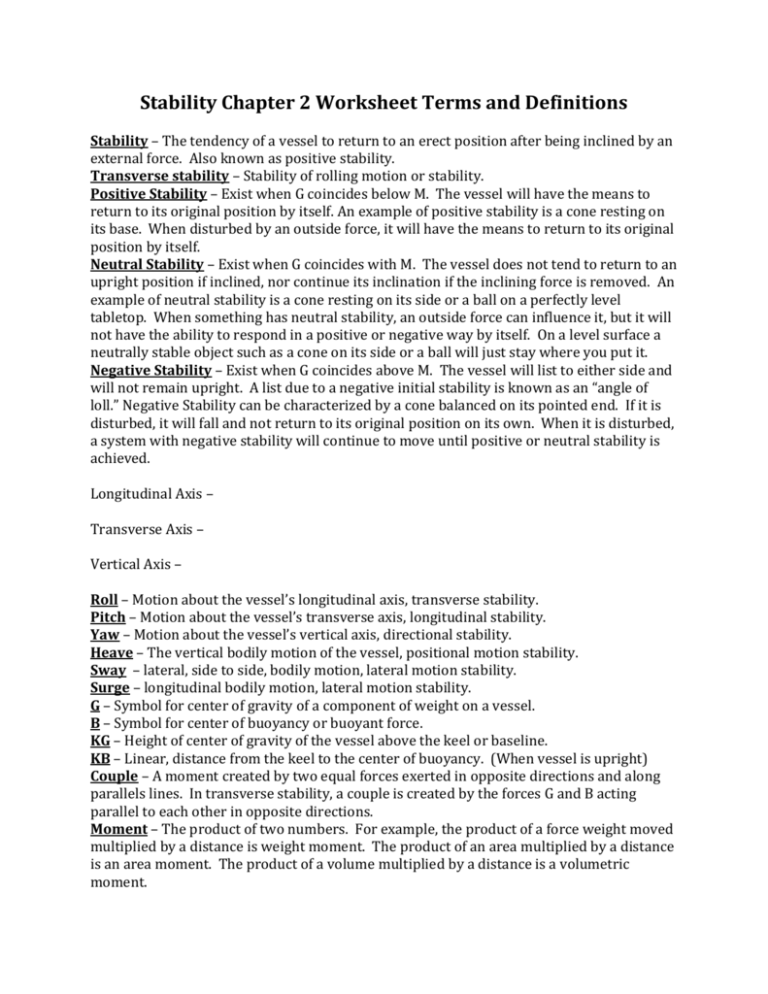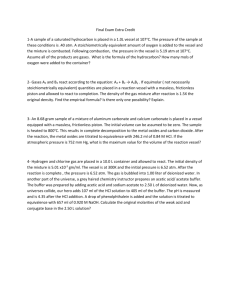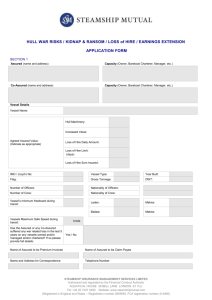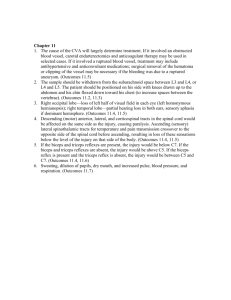Stability Chapter 2 Worksheet Terms and Definitions
advertisement

Stability Chapter 2 Worksheet Terms and Definitions Stability – The tendency of a vessel to return to an erect position after being inclined by an external force. Also known as positive stability. Transverse stability – Stability of rolling motion or stability. Positive Stability – Exist when G coincides below M. The vessel will have the means to return to its original position by itself. An example of positive stability is a cone resting on its base. When disturbed by an outside force, it will have the means to return to its original position by itself. Neutral Stability – Exist when G coincides with M. The vessel does not tend to return to an upright position if inclined, nor continue its inclination if the inclining force is removed. An example of neutral stability is a cone resting on its side or a ball on a perfectly level tabletop. When something has neutral stability, an outside force can influence it, but it will not have the ability to respond in a positive or negative way by itself. On a level surface a neutrally stable object such as a cone on its side or a ball will just stay where you put it. Negative Stability – Exist when G coincides above M. The vessel will list to either side and will not remain upright. A list due to a negative initial stability is known as an “angle of loll.” Negative Stability can be characterized by a cone balanced on its pointed end. If it is disturbed, it will fall and not return to its original position on its own. When it is disturbed, a system with negative stability will continue to move until positive or neutral stability is achieved. Longitudinal Axis – Transverse Axis – Vertical Axis – Roll – Motion about the vessel’s longitudinal axis, transverse stability. Pitch – Motion about the vessel’s transverse axis, longitudinal stability. Yaw – Motion about the vessel’s vertical axis, directional stability. Heave – The vertical bodily motion of the vessel, positional motion stability. Sway – lateral, side to side, bodily motion, lateral motion stability. Surge – longitudinal bodily motion, lateral motion stability. G – Symbol for center of gravity of a component of weight on a vessel. B – Symbol for center of buoyancy or buoyant force. KG – Height of center of gravity of the vessel above the keel or baseline. KB – Linear, distance from the keel to the center of buoyancy. (When vessel is upright) Couple – A moment created by two equal forces exerted in opposite directions and along parallels lines. In transverse stability, a couple is created by the forces G and B acting parallel to each other in opposite directions. Moment – The product of two numbers. For example, the product of a force weight moved multiplied by a distance is weight moment. The product of an area multiplied by a distance is an area moment. The product of a volume multiplied by a distance is a volumetric moment. Righting Moment – The product of the weight of a vessel (displacement or ∆) and the righting arm (GZ), so = ∆GZ GZ – Symbol for writing arm; horizontal distance measured between the vertical lines of forces between G and B. GZ is measured horizontally from G to a point of intersection of the upward line of force from B at a point labeled Z. Transverse Metacenter (M) – The highest point to which G may rise and still permit the vessel to have positive stability. Found at the intersection of a line of action of B when the ship is erect with the line of action of B when the ship is given small inclination. The height of the transverse metacenter above the keel, KM, KMt, or TKM. GM – Metacentric height; distance from the center of gravity (G) to the transverse metacenter (M) BM – Symbol for transverse metacentric radius; distance between center of buoyancy (B) and transverse metacenter (M). Formulas: Righting Moment = (∆)(GZ) = product of the vessel (displacement) x righting arm (GZ) Sin(Theta) = GZ/GM = righting arm x metacentric height







